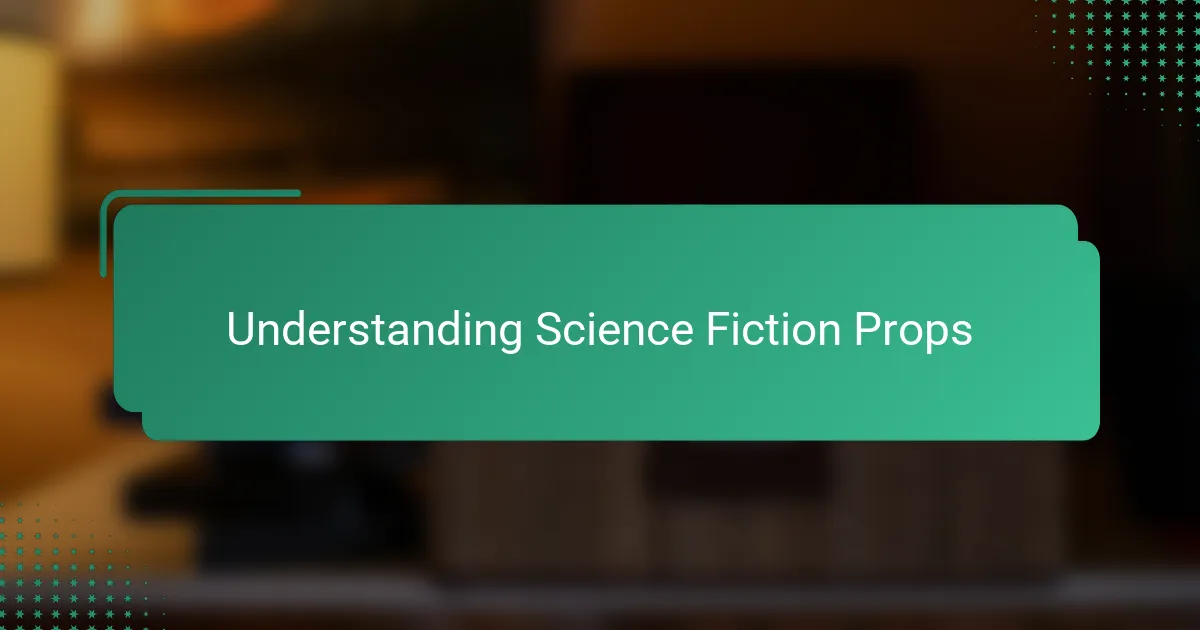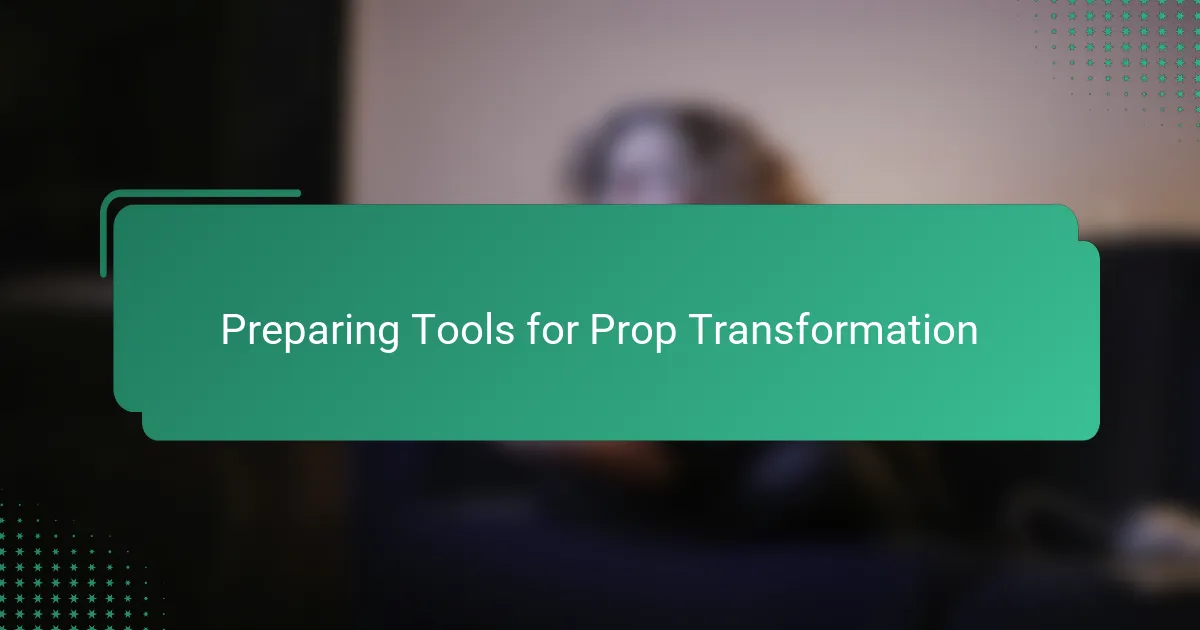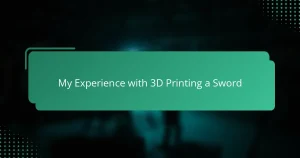Key takeaways
- Science fiction props transform everyday tools into imaginative devices, encouraging viewers to rethink technology.
- Choosing the right tools involves assessing their shape, texture, and potential for storytelling to create an immersive experience.
- Modification techniques, including reshaping and adding details, enhance the sci-fi aesthetic and realism of the props.
- Personalizing props with unique touches and narratives creates emotional connections and enriches their backstory.

Understanding Science Fiction Props
Science fiction props are more than just objects; they are gateways to other worlds and stories. When I first started collecting old tools to transform into these props, I realized that understanding their role is key—they’re meant to spark imagination and convey technology that doesn’t yet exist. Have you ever held a prop and felt instantly transported to a future universe? That’s the magic behind these creations.
In my experience, the best sci-fi props balance familiarity with the unknown. Tools we might recognize get reshaped into something unearthly, challenging the viewer to rethink what technology can be. It’s this blend that makes the props feel authentic and immersive, even if they started as simple, everyday items.
What fascinates me most about science fiction props is how they encourage creative problem-solving. They ask, “How can I make this look advanced without actual advanced tech?” This challenge drove me to repurpose old tools not just out of necessity but as a deliberate design choice, giving each piece a story and purpose that echoes sci-fi’s adventurous spirit.

Choosing Old Tools for Repurposing
When I first began choosing old tools for repurposing, I quickly realized that not every tool has the right shape or texture to spark that futuristic vibe. Some tools just feel too plain or outdated in a way that doesn’t translate well on screen. So, I’d ask myself: does this object have a story waiting to be told, or is it just clutter?
I’ve found that tools with interesting contours, unexpected mechanical parts, or unique handles often make the best starting points. One rusty wrench, for example, caught my eye because its curved form and sturdy build hinted at a device from another world. It’s amazing how such small details can shape the whole feel of a prop.
Sometimes, I also consider the tool’s material and wear—can I easily modify it without losing its essence? Picking something too fragile or too modern can ruin the illusion I want to create. It’s a balancing act between function and fantasy, and that process of choice is half the fun. Have you ever held a worn screwdriver and imagined it as a high-tech gadget? That’s exactly the kind of mental leap I love encouraging.

Preparing Tools for Prop Transformation
Before diving into any transformation, I always give my chosen tools a thorough cleaning. Sometimes, years of rust and grime obscure the unique shapes that grabbed my attention in the first place. Have you ever tried to see the potential in a grimy old hammer? Once I scrub and sand off the dirt, those hidden details start to shine through, revealing the sci-fi possibilities beneath.
Next, I carefully assess each tool for structural integrity. It might sound tedious, but I’ve learned the hard way not to get too attached to a piece that’s crumbling or too brittle to work with. Ensuring the tool can withstand cutting, gluing, or painting saves a lot of wasted effort—and frustration—down the line.
Finally, I strip away any parts that feel too grounded in reality, like obvious manufacturer labels or mundane handles. This step helps me mentally and physically prepare the tool to become something otherworldly. It’s like erasing its history so I can rewrite its future as a prop. Have you ever felt that moment when an old wrench suddenly stops being just a wrench? That’s where transformation truly begins.

Techniques for Modifying Tools
Modifying old tools is where the real magic happens. I often start by carefully cutting away or reshaping handles and edges to break their familiar silhouette. It’s surprising how a few snips with a rotary tool can turn a plain wrench into the chassis of a futuristic communicator.
Sometimes, I add layers using materials like foam, plastic sheets, or metal scraps to build out details that suggest advanced technology. Have you noticed how even subtle additions—like a tiny glowing button or a strange antenna—can shift a tool’s entire vibe? These small touches create a sense of complexity that’s essential for believable sci-fi props.
Painting is another game-changer. I like to use weathering techniques—dry brushing metallic colors or applying grime washes—to give surfaces an aged yet high-tech look. It’s fun watching an ordinary screwdriver transform into a relic from a distant future just by layering colors and textures. Have you ever thought about how much character paint can add to a prop? In my experience, it’s the finishing touch that truly sells the illusion.

Adding Sci-Fi Details and Effects
Adding sci-fi details is where I let my imagination run wild. Small, unexpected elements like tiny wires, LED lights, or strange symbols can instantly transport a prop from ordinary to otherworldly. Have you ever noticed how a flickering light or a mysterious dial can make you believe a tool is powered by alien technology? That little spark of fantasy is exactly what I aim to capture.
I also enjoy experimenting with different textures and finishes to create illusions of advanced materials. Sometimes, layering translucent plastic over metallic paint hints at energy fields or force shields. It’s fascinating how subtle effects like glowing edges or pulsating lights add depth without overwhelming the original structure. In my experience, these details invite viewers to ask, “What does this device do, and how does it work?”
What’s been most rewarding is seeing how these additions breathe new life into otherwise forgotten objects. A stripped-down wrench decorated with intricate circuits and weathered metal suddenly feels like a gadget from a distant starship. It’s those moments—when an old tool tells a fresh story—that remind me why I love this creative process so much. Do you ever find yourself staring at a prop, imagining its untold history? That’s the magic of adding these sci-fi details and effects.

Personalizing Repurposed Props
Personalizing repurposed props is where I truly make each piece my own. After shaping and detailing the tool, I like to infuse it with elements that resonate with my vision—whether that’s scratches that tell tales of intergalactic battles or unique color schemes that evoke alien worlds. Have you ever noticed how tiny imperfections can make a prop feel more real? Those details speak volumes to me about the character of the object.
One time, I added a faded insignia to a handheld device I’d crafted from an old multimeter. That little touch transformed it from a generic gadget into a relic with a backstory, as if it belonged to a long-lost space faction. It’s amazing how personalization brings an emotional connection—not just for me, but for anyone who interacts with the prop later.
I also think about tone and style when personalizing. Will it look sleek and high-tech, or rugged and battle-worn? These choices shape how the prop fits into the larger sci-fi narrative I’m creating. By layering texture, paint, and small modifications, I feel like I’m writing a silent story through every scratch and detail. Don’t you find that these personal touches turn a simple object into a captivating piece of visual storytelling?

Showcasing Completed Sci-Fi Props
Seeing my finished sci-fi props displayed is always a special moment. I remember once setting up a collection of repurposed tools on my workbench, and suddenly that old wrench, now transformed with LED lights and weathered paint, didn’t look like a tool anymore—it looked like a piece of a futuristic puzzle. It struck me how far a bit of imagination and effort could carry something from forgotten junk to captivating art.
When I showcase these props, I like to think about the stories they could tell. Have you ever looked at a gadget and imagined all the adventures it’s been through? I find it rewarding how viewers often lean in closer, intrigued by the details—scratches, symbols, or subtle effects that hint at a larger universe. Those reactions make the whole process feel worthwhile.
Sometimes, I even arrange photos of my props in themed groups—like weapons, communication devices, or navigation instruments—to build a mini sci-fi world right at home. This organization not only highlights each piece’s unique features but also illustrates how old tools, with a bit of creativity, can become keys to whole new stories. Don’t you love when an object invites you into its fictional world just by the way it looks?


